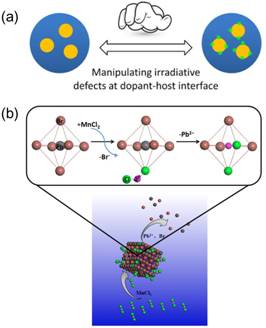Prof. Yiping Cui’s research group from Southeast University has achieved important progress in micro-nano photonic materials. With more than one hundred works published in famous journals including ACS Nano, Adv. Funct. Mater., Adv. Mater. and Small, Prof. Cui’s group has drawn impressive attention from researchers all over the world. Prof. Cui is selected as one of the “Most Cited Chinese Researchers” in 2016. Most recently, Prof. Cui’s group published a review article in Chemical Reviews,which systematically summarizes SERS based immunoassays.
In fabrication and photoregulation of quantum dots (QDs), Prof. Chunlei Wang from Prof. Cui’s group has been working on interface manipulation and molecular doping of QDs. They proposed the concept of “dopant–host interface defects”, which provides a new avenue toward the manipulation of QDs emission (Adv. Funct. Mater. 2016, 26, 4274, IF: 12.124). Lately, Prof. Chunlei Wang presented a strategy to dope MnCl2molecules into preformed CsPbBr3perovskite nanocrystals, which is instructive for endowing perovskite with peculiar optical, electron-spin and magnetic properties via a postsynthesis molecular exchange (Adv. Mater.2017, DOI:10.1002/adma.201700095, IF: 19.791).

Figure 1. (a) Manipulation interfaces of QDs. (b) Molecular exchange doping of QDs.
In nano-biological detection and cancer diagnosis, Prof. Zhuyuan Wang from Prof. Cui’s group has constructed a series of SERS optical nanoprobes. They established several optical encoding methods such as SERS-fluorescence joint spectral encoding and SERS-spatial joint encoding. These optical encoding methods can be used in high throughput biological detection and cancer theranostics (J. Am. Chem. Soc., 134, 2993, 2012, IF: 13.858). Meanwhile, they presented a SERS based in situ hybridization method for measuring telomere length, which is quite beneficial for early-stage detection of cancerous diseases (ACS Nano, 2016, 10, 2950, IF: 13.942). Recently, Prof. Zhuyuan Wang fabricated a kind of integrated SERS microfluidic chips with high sensitivity and high throughput. These chips can be employed in multiplex immuno-detection and investigation of intercellular communications (Small2015, 11, 2798, IF: 8.643; Nano Research 2017, 10, 584, IF: 7.354).
Owing to their outstanding work in biosensing and biodetection, Prof. Cui’ group published a review article in Chemical Reviews, entitled “SERS-Activated Platforms for Immunoassay: Probes, Encoding Methods, and Applications” (Chem. Rev. 2017, DOI: 10.1021/acs.chemrev.7b00027, IF: 47.928). This review summarizes the research progresses, scientific problems and future perspectives of SERS immunoassays.
The above research works are supported by theNational Key Basic Research Program of China, Natural Science Foundation of China, the Excellent Youth Foundation of Jiangsu Provinceand the Fundamental Research Funds for the Central Universities.

Figure 2. (a) SERS based in situ hybridization for telomere length assessment. (b) Platforms for SERS immunoassays.
Links of full papers:
http://onlinelibrary.wiley.com/doi/10.1002/adfm.201505172/pdf
http://pubs.acs.org/doi/abs/10.1021/acsnano.6b00198
http://dx.doi.org/10.1002/adma.201700095
http://pubs.acs.org/doi/pdfplus/10.1021/acs.chemrev.7b00027
http://pubs.acs.org/doi/abs/10.1021/ja208154m
http://onlinelibrary.wiley.com/doi/10.1002/smll.201403474/abstract

